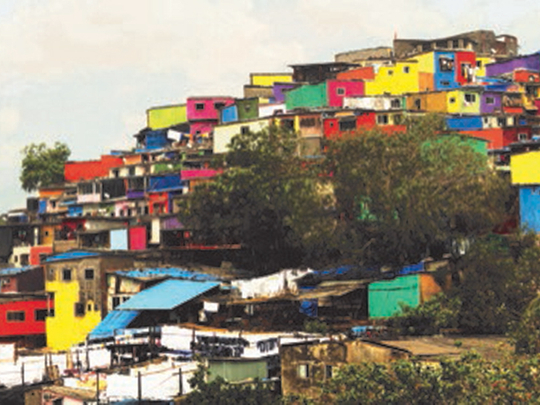
Mumbai Mumbai’s slums often look sad and dull from the exterior but now an innovative young woman and her team have begun giving a dash of colour and vibrancy to the walls of these shanties on the slopes of Asalpha Village, a crowded suburb in Ghatkopar, and sure enough the makeover has made a huge impact on everyone’s lives.
The initiative called Chal Rang De (Let’s give colour) aims to transform the face of the city and turn urban slums into art canvases that not only change the outlook of passers-by but also create a positive emotion among residents.
It’s the brainchild of Dedeepya Reddy, co-founder of FruitBowl Digital, a consultation agency, who says, “The idea dawned on me when I was passing through Asalpha, looking at the slums on the slopes and thinking how sad it seemed.”
Coming from a background of design and doing creative work, she wondered, “If I could bring about a change what would I do, I thought. I remembered how people around the globe had brought colour into their environment — like in the slums of Rio de Janeiro in Brazil,” she told Gulf News.
In a moment. “I saw a beautiful piece of architecture on the slopes of Asalpha slums and how a rainbow of colours would change the way people look at slums, at the poor.”
The mission to paint the walls took wings and soon she put out a post on Facebook “which drew an overwhelming response from 1,500 people in just a matter of four to five days. We actually needed just 350 people who were invited to colour more than 120 walls in a short span of three days — on December 2, 3 and 4.”
FruitBowl in collaboration with Mumbai Metro One, Snowcem Paints and Co. Lab Oratory Asia initiated the Chal Rang De movement that brought out enthusiastic volunteers ready to go at their job.
“We first got the permission of Asalpha Slum Society members as well as Mumbai Police who gave us superb support,” says Shetty. “Slum residents were certainly happy but came up with questions like, ‘Why are you doing?’, ‘Are you getting money?’, ‘Why are you colouring my house?’ and so on. They just couldn’t digest that someone was ready to do something for them. Eventually they were all thrilled and cooperated with us.”
Even as the team went about painting all day and night, they made friends with the residents whose homes they found were far more clean than they had imagined and who made sure any litter was immediately removed.
Women offered to keep the paint equipment and bags safely in their homes. The richness of this experience has made the team come up with more ideas: on December 14 artists will come and put up their installation and works through the narrow lanes of these slums.
The once drab Asalpha Village is now looks fabulous with walls shimmering in hues of bright red, pink, yellow and blue.













